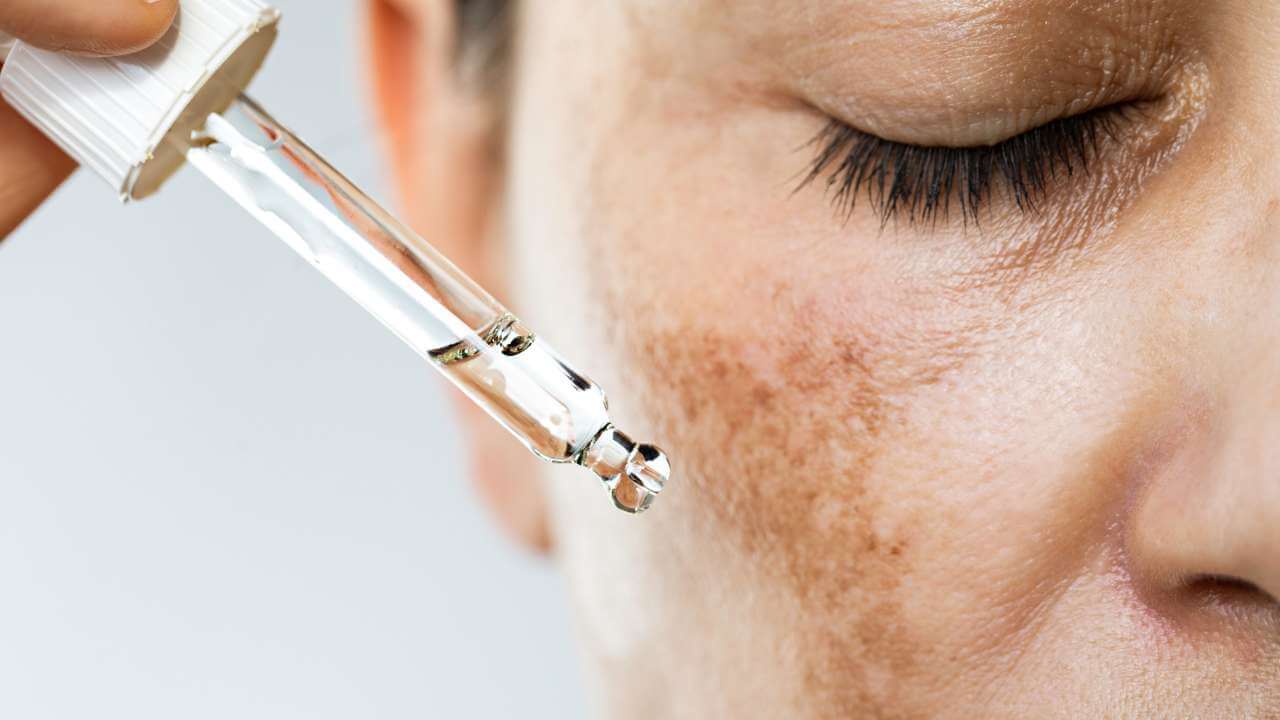Looking for solutions to your melasma problem?
Do you have dark areas of skin around your mouth, forehead, nose, or cheeks that won't go away no matter what you do? You may be suffering from a condition known as melasma.
Did you know there are multiple ways of treating melasma? Depending on the severity of the case, a treatment plan could vary from natural self-care methods like avoiding UV radiation from sun exposure or harsh chemicals to professional medical procedures such as chemical peels or laser therapies.
In this article, we'll explore what melasma is, what causes it, and what you can do to manage it. We'll also discuss some tips for preventing melasma from developing in the first place, so you can feel more confident and comfortable in your skin.
Key Takeaways:
- Melasma is a common hyperpigmentation disorder that causes discolored dark patches on the skin. Melasma affects 5 million people in the US.
- The exact cause of melasma is unknown, but it is believed to be linked to abnormal activity of melanocytes.
- Possible causes include sun exposure, pregnancy, hormone therapy, stress, and genetics.
- Melasma treatments can include hydroquinone, corticosteroids and tretinoin, triple creams, microdermabrasion, chemical peels, laser treatment, light therapy, or dermabrasion.
What is Melasma?
Melasma is one of many different types of hyperpigmentation disorders that result in discolored patches on the face and surrounding skin, darker than a person’s original skin color.
While its prevalence varies from 1.5-33% depending upon the population, melasma appears to be one of today's most common and puzzling skin conditions for individuals to deal with.[1]
Individuals with medium brown to darker skin tones that are regularly exposed to the sun’s harmful rays without adequate sun protection may develop melasma at some point in their life.
Women, in particular, may observe dark patches appearing on their faces - areas such as the cheeks, bridge of the nose, and forehead are common locations. While melasma occurs in both genders, women account for almost 90% of those affected by this condition.[2]
Melasma is most commonly found on the face, specifically around the nose, forehead, cheeks, upper lip, and chin. Additionally, areas exposed to more sunlight—such as your forearms, neck, and shoulders—may also be affected by melasma as well.
Symptoms of Melasma
The most common sign of melasma is hyperpigmentation, which leads to patchy areas on the skin that are usually darker than an individual's natural complexion.
These may vary in color from gray or brown and appear as flat discolorations with no physical signs of discomfort.[1]
Although the sight of these melasma patches can be frustrating for some people, they do not cause any pain or discomfort.
It is important to understand that melasma does not indicate a form of skin cancer, though it could resemble other skin disorders. To guarantee an accurate diagnosis and receive the proper treatment, you should contact a board-certified dermatologist.
Causes of Melasma
While the underlying cause of melasma is still a mystery to medical professionals, it has been suggested that abnormal activity of melanocytes (the pigment cells responsible for skin pigmentation) may be at fault.
Melanocytes are naturally abundant in people with light brown skin or darker skin tones and as such, they tend to be more susceptible to developing this condition than those with lighter-toned fair skin.
Some other causes include:[2]
1) Sun Exposure
Spending too much time in the sun can be a primary factor in developing post-inflammatory hyperpigmentation and melasma. Overexposure to UV rays without proper sun protection and other environmental factors can cause skin irritation and damage the skin's protective barrier that is often associated with this skin condition.
2) Pregnancy
Pregnancy often brings along melasma, often referred to as the "mask of pregnancy" which can affect up to half of all pregnant women. This is thought to be caused by the hormonal changes that occur during the second or third trimester of pregnancy.
3) Birth Control Pills
Furthermore, melasma can be triggered by estrogen and progesterone sensitivity. This implies that hormone therapy, and the use of oral contraceptives (taking birth control pills), may result in this condition.
4) Estrogen/ Diethylstilbestrol
The introduction of Diethylstilbestrol, a synthetic form of estrogen used in various therapeutic procedures, has shed light on the relationship between hormone levels and melasma. Consequently, individuals with higher amounts of estrogen during hormonal contraception may be more susceptible to developing this skin disorder.
5) Stress
Although controversial, it is widely accepted that stress and thyroid disease can be contributing factors to melasma. Stress is thought to cause an increase in the hormones cortisol and epinephrine, which can trigger melasma. Furthermore, thyroid-related disorders such as hypothyroidism or hyperthyroidism are believed to lead to increased production of melanin – the pigment that can cause patches of discoloration on the skin.
6) Genetics
Genetics and family history play a role in melasma, as up to half of those with the condition have reported that relatives also suffer from it.

Treating Melasma
In some cases, treatment for melasma may not be needed at all.
If the skin discoloration due to melasma appears - such as during pregnancy, hormone replacement therapy, or while taking birth control pills - then it should naturally subside after giving birth or discontinuing the pills or therapy.
Melasma can be a long-term struggle, and even a successful treatment plan doesn't guarantee that it won't eventually return.
To ward off the condition in the first place, your dermatologist will likely recommend using an SPF 30+ sunscreen on any exposed skin throughout the year. If melasma persists despite preventative measures, then you may want to explore treatment options such as laser therapy or chemical peels to reduce its appearance over time.
Finding the ideal treatment for melasma can be overwhelming; however, there are numerous strategies to consider. These approaches include:
1) Hydroquinone
Hydroquinone is widely regarded as the best topical therapy for treating melasma. It comes in a lotion, cream, or gel form and directly lightens patches on the skin that have become discolored or uneven. This powerful product requires a prescription from a medical professional, but it's worth getting if you want to effectively treat those pesky areas of dark pigmentation!
2) Corticosteroids and Tretinoin
To reduce the discoloration of melasma patches, corticosteroids and tretinoin can be used in creams, lotions, or gels. These treatments are known to help with skin lightening significantly - making them popular choices amongst those looking for effective solutions to uneven pigmentation.
3) Triple Creams
Occasionally, to treat melasma more effectively, a dermatologist may prescribe triple creams that combine hydroquinone, corticosteroids, and tretinoin. These potent concoctions are highly effective at restoring vibrancy and health to the affected area.
4) Other Topicals
Dermatologists may prescribe an alternative medicated cream such as glycolic acid, azelaic acid, or kojic acid, which is specifically designed to lighten the darker patches of skin. There are also many glycolic face washes, body washes for hyperpigmentation, and vitamin C facial serums on the market to tackle those dark spots which we have already selected for you at HealthMention.
5) Medical Procedures
If topical medications fail to bring the desired skin lightening results, a board certified dermatologist may suggest alternative targeted therapies such as:
- Microdermabrasion
- Chemical peel
- Laser treatment
- Light therapy or dermabrasion
However, it is important to be aware of any side effects or potential risks associated with these procedures before committing. Therefore you must consult your doctor or dermatologist to determine which option will best serve your needs and provide the safest outcome.
If you have encountered melasma before, you can attempt to reduce the likelihood of another outbreak by protecting yourself from potential triggers. This includes avoiding direct sun exposure as much as possible and wearing a wide brimmed hat when outside; in addition, make sure to always lather up with sunscreen for added protection against harmful UV rays!
Did We Mention...
What is Melasma FAQs?
Melasma is a skin condition that can be difficult to diagnose and treat. The symptoms of melasma can vary from person to person, making it hard to know if you have it or how to treat it.
We've compiled a list of the most common questions people ask about melasma. This FAQ guide will help you learn more about this condition and what treatment options are available.
Q: What Exactly Happens in the Skin During Melasma?
Three layers make up the surface of your skin: the epidermis, dermis, and hypodermis. The epidermal or outer layer of skin contains cells known as melanocytes which produce the naturally occurring dark pigment named melanin. The production of melanin increases in response to sun exposure, heat or ultraviolet radiation to protect the skin from skin cancer, or hormonal influences - this explains why we start to see darker skin.
Q: What Are the Different Types of Melasma?
Melasma is a skin condition that has three distinct types based on the pigment's depth.
- Epidermal melasma, which can be identified by its dark brown hue and clear-cut outline, looks more apparent under black light and reacts favorably to treatment.
- Then we have dermal melasma with its faint bluish or tan shade plus an indistinct border; it does not change when exposed to blacklight but rarely responds positively to treatment.
- Lastly, mixed melasma—the most frequent type of all—features both blueish and brown patches as seen in a mixed pattern under black light; Fortunately, this kind of pigmentation typically responds to therapeutic treatment.
Q: Do Certain Foods Worsen Melasma?
While no foods or drinks may directly cause, cure, or worsen melasma according to experts, you can maintain your skin's health by introducing a diet full of vitamin D-rich choices such as almond milk, eggs, meat, milk mushrooms, oily fish like salmon and sardines; orange juice and yogurt.
Q: How To Diagnose Melasma?
To diagnose melasma, the American Academy of Dermatology suggests a visual inspection of the affected region is usually sufficient. Nevertheless, to rule out other potential causes of this condition, your healthcare provider may opt for certain tests such as Wood’s lamp examination and biopsy.[3]
When using Wood's Lamp Examination technique, special lighting is held close to the skin to identify any bacterial or fungal infections as well as to determine how many skin layers are afflicted by melasma lesions. If needed, a biopsy can also be performed during which a small sample of the affected skin will be removed for additional testing to uncover any underlying medical concerns.
Q: Can Melasma Naturally Improve Without Treatment?
While your melasma may eventually fade away within several months naturally, this will likely not occur while you are expecting a baby or using hormone contraceptives. Take proactive steps such as avoiding direct sunlight to keep the situation from progressing and also to prevent any potential recurrence in the future should it eventually disappear.

The Final Mention
Melasma is a relatively common skin condition that affects nearly 5 million people in the US alone,[4] but with the right knowledge and treatment options it is easily manageable. Whether you are looking to take preventive measures or are currently affected by melasma, understanding your condition is key to taking proper care of your skin.
You now have the necessary tools to choose an appropriate plan of action that is best suited to your particular needs. Learning more about this condition can make all the difference in achieving healthier-looking skin.
If you develop melasma, be sure to consult with a dermatologist to answer any of your remaining questions or concerns and expert advice on how to best manage this condition.
It's time to take control, so what are you waiting for? Share your experiences in the comments below and be sure to spread awareness and talk openly about this common skin disorder.
✅ 4 Sources
HealthMention only uses sources from authoritative and reliable resources, such as peer-reviewed studies, to strengthen the accuracy of our content.
- Basit H, Godse KV, Al Aboud AM. Melasma. PubMed. Published 2021. https://www.ncbi.nlm.nih.gov/books/NBK459271/
- Situm M, Kolić M, Bolanca Z, Ljubicić I, Misanović B. Melasma--updated treatments. Collegium Antropologicum. 2011;35 Suppl 2:315-318. Accessed March 31, 2023. https://pubmed.ncbi.nlm.nih.gov/22220462/
- Ogbechie-Godec OA, Elbuluk N. Melasma: an Up-to-Date Comprehensive Review. Dermatology and Therapy. 2017;7(3):305-318. doi:https://doi.org/10.1007/s13555-017-0194-1
- Melnick S, Lohani S, Alweis R. Hyperpigmentation in a middle aged woman: a common yet underdiagnosed condition. J Community Hosp Intern Med Perspect. 2016;6(3):31544. Published 2016 Jul 6. doi:10.3402/jchimp.v6.31544 https://www.ncbi.nlm.nih.gov/pmc/articles/PMC4942510/









